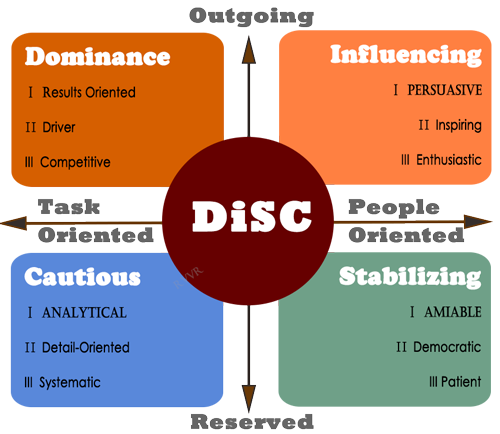DiSC personality test
DISC is a behaviour self-assessment tool originally based on the 1928 DISC emotional and behavioural theory of psychologist William Moulton Marston, which centred on four personality traits: Dominance, Inducement, Submission, and Compliance. This theory was then developed into a behavioural assessment tool by industrial psychologist Walter Vernon Clarke.

Marston was a lawyer and a psychologist; he also contributed to the first polygraph test, authored self-help books and created the character Wonder Woman. He generated the DISC characteristics of emotions and behavior of normal people (at the time, ‘normal’ had the meaning of ‘typical’ rather than an antonym for ‘abnormal’).
He published his findings in his 1928 book called Emotions of Normal People in which he explained that the four personality types (yellow, green, blue and red) arise as variations between people. According to Marston, people illustrate their emotions using four behavior types: Dominance, Influence, Steadiness, and Compliance. He argued that these behavioral types came from people’s sense of self and their interaction with the environment. He based the four types on two underlying dimensions that influenced people’s emotional behavior. The first dimension is whether a person views their environment as favourable or unfavourable. The second dimension is whether a person perceives themselves as having control or lack of control over their environment.[citation needed]
Although Marston contributed to the theory of the DISC itself, he did not create the DISC self-assessment. In 1956, Walter Clarke, an industrial psychologist, constructed an self-assessment based on Marston’s theory. Clarke created the Activity Vector Analysis, a self-checklist of adjectives on which he asked people to indicate descriptions that were accurate about themselves.[3] This self-assessment was intended for use in businesses needing assistance in choosing qualified employees.
Merenda, Peter F. and Clarke published their findings on a new instrument in the January 1965 issue of the Journal of Clinical Psychology.”Instead of using a checklist, the “Self Description” test forced respondents to make a choice between two or more terms. Factor analysis of this assessment added to the support of a DISC-based instrument. “Self Description” was used by John Geier to create the Personal Profile System in the 1970s.
DISC has been used to help determine a course of action when dealing with problems as a leadership team—that is, taking the various aspects of each type into account when solving problems or assigning jobs.
In 2014, Thomas Erikson wrote a book titled Surrounded by Idiots describing the DISC model and aiming at popularizing it. The book sold over 1.5 million copies worldwide.
The above is From Wikipedia.
Scan the QR code below to download a professional evaluation APP, which supports Android and IOS systems.

